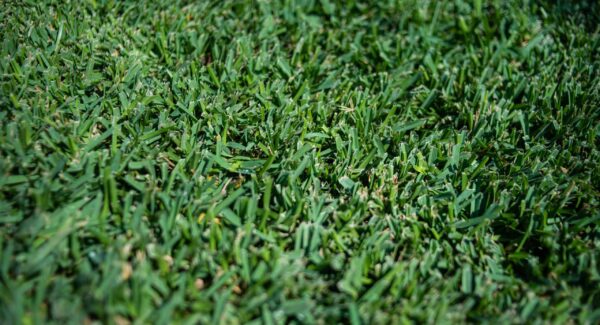Best Grass for High Traffic Areas
The constant foot traffic and activities can make keeping the lawn thick, lush, and vibrant challenging.
However, by following the proper lawn care methods, you can maintain a high-traffic lawn. The key is to select a grass variety that is resistant to wear and tear. Frequent use can cause soil compaction, thinning, and overall damage if you choose the wrong grass type.
Opting for the varieties for high-traffic areas will help your lawn endure heavy use while preserving its health and appearance. Let’s explore which grass types are most suitable for such areas.

Key Characteristics of Grass for High-Traffic Areas
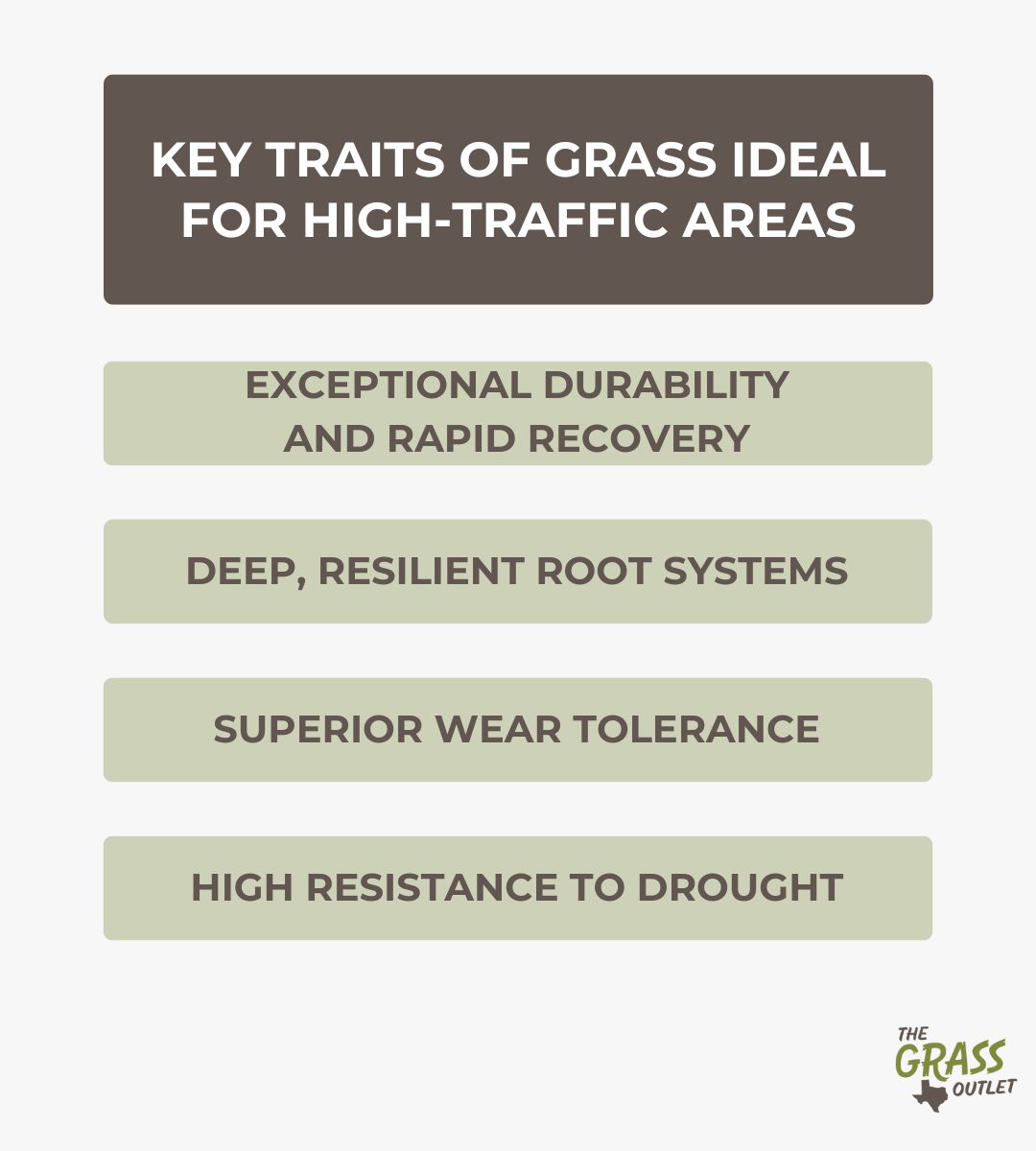
Durability and Quick Recovery: Grasses must bounce back and regrow after damage. Vigorously growing grasses can quickly spread and fill in any damaged spots, speeding up recovery from foot traffic.
Root Strength: Grasses with deep, strong roots provide better stability and resistance to wear. Deeper roots enhance drought tolerance and help the grass withstand environmental stress. This strength translates into excellent wear resistance and less damage from consistent foot traffic.
Wear Tolerance refers to the grass’s capacity to endure frequent use without showing signs of thinning or decline. Grasses in high-traffic areas must withstand regular activity without breaking down quickly. High wear tolerance ensures the lawn remains lush and full, even with continuous use.
Drought Resistance: The grass’s ability to survive with minimal water, especially during dry spells, is vital for high-traffic areas. Heavy traffic can compact the soil, making it harder for water to penetrate, leading to dry conditions. Drought-resistant grasses can better handle this stress and continue thriving with less moisture.
Best Warm-Season Grasses for High-Traffic Lawns
When searching for a grass type that maintains its appearance and durability under heavy use, it’s essential to begin with varieties suited to your region’s climate. With warm temperatures almost year-round in Texas, warm-season grasses such as Bermuda, Zoysia, and St. Augustine are excellent options. Next, we delve into the characteristics of each, offering key insights to help you select the most suitable variety.
Bermuda grass
Bermuda grass is an exceptionally resilient type of grass with deep roots and a rapid growth rate.
It has an aggressive growth pattern, spreading through above-ground stolons and below-ground rhizomes, allowing it to create a thick turf quickly. This characteristic also makes Bermuda grass lawns highly resistant to heavy foot traffic and enables them to recover rapidly from damage.
Bermuda grass is renowned for its durability and popular choice for golf courses, sports fields, playgrounds, and frequently used lawns.
It thrives in warm climates and is drought-tolerant, making it ideal for sandy soils. Its color can vary from blue-green and grey-green to dark green.
Varieties available from The Grass Outlet: Celebration Bermuda, Tifway 419 Hybrid Bermuda
Zoysia Grass
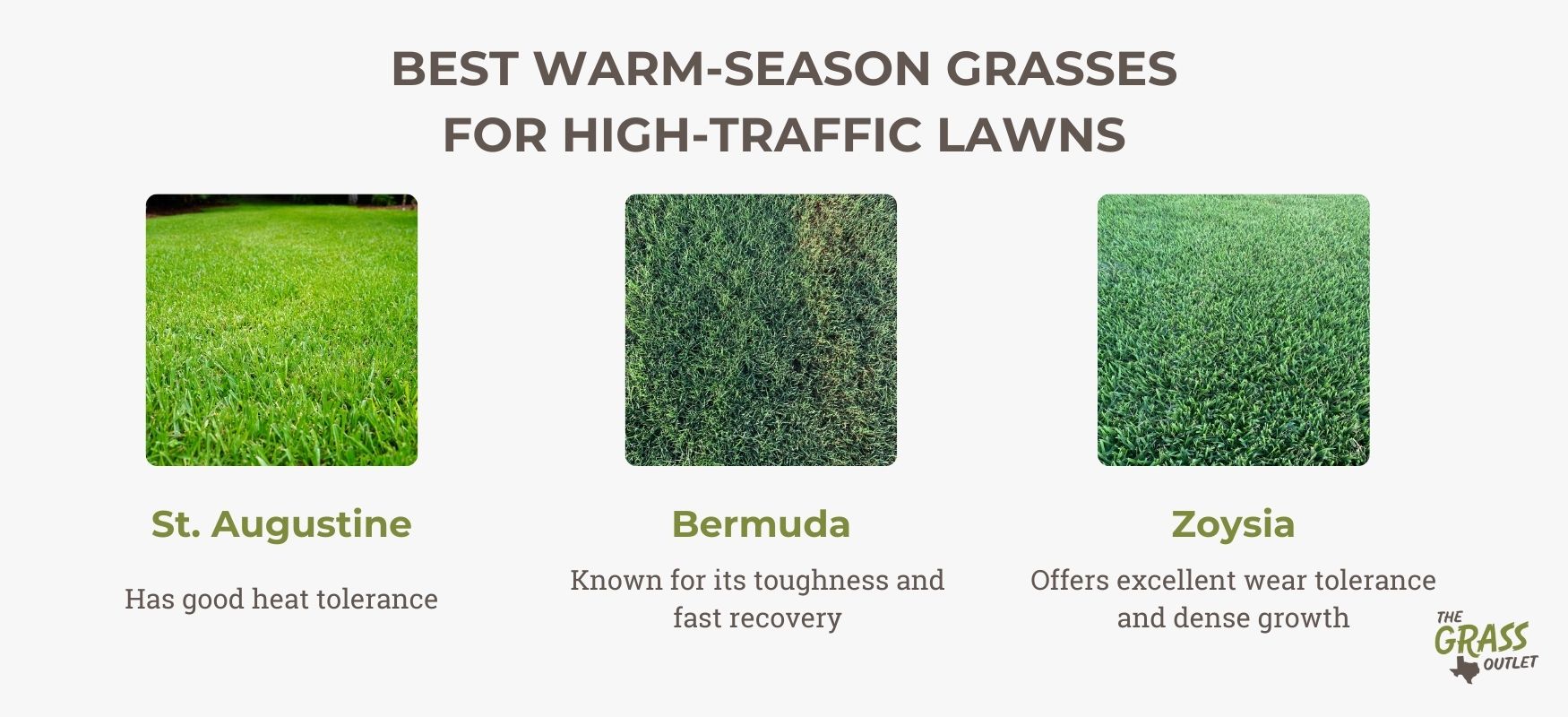
Zoysia grass is a durable warm-season grass known for its dense growth pattern. This thickness creates a lush, carpet-like turf that can endure heavy use, contributing to its durability. It adapts to various soil types.
Zoysia grass has a deep root system, which helps it draw water from deep within the soil, enhancing its drought resistance. This deep rooting also allows it to recover from damage, though its slower growth habit means it does not recover as quickly as Bermuda.
Zoysiagrasses have the highest lignified tissue concentration among turfgrasses, which is part of the reason zoysiagrass makes such an excellent playing surface that resists wear.
The color and texture of Zoysia grass can vary, but it typically ranges from light to medium green.
A key advantage of Zoysia over Bermuda grass is its shade tolerance. While it prefers full sun, it performs better in shaded areas, making it a good choice for properties with partial shade.
Varieties available from The Grass Outlet: Zeon Zoysia, Palisades Zoysia
St. Augustine Grass
St. Augustine grass might not handle heavy wear and tear as effectively as Bermuda or Zoysia, but its broad leaves help to endure moderate use. It spreads rapidly through stolons, creating a lush, dense turf with an appealing blue-green hue. This growth pattern enables it to fill in worn patches relatively quickly and recover from damage in certain situations.
It is best suited for residential lawns with moderate foot traffic, like backyards where children might occasionally play or people walk. It’s ideal for locations that combine partial shade with lighter use rather than high-traffic sports fields or playgrounds.
Available varieties from The Grass Outlet: Raleigh St. Augustine, Palmetto St. Augustine, Texas Native.
Additional Considerations for High-Traffic Lawns
There are a few extra factors to consider when choosing suitable grass for high-traffic lawns. Here’s what to consider when selecting the best grass for areas that endure heavy use.
Avoid Compacted Soil
High foot traffic and frequent use often result in soil compaction, a common cause of damage in high-traffic areas. This occurs when soil particles are pressed tightly, reducing pore space and limiting air and water movement. Compacted soil struggles to support robust root growth, leading to weaker, less resilient turf. Identifying and addressing soil compaction is essential for maintaining soil health.
Keeping the soil loose is crucial to maintaining healthy grass in high-traffic areas. Soil aeration is the most effective way to achieve this.
Keep the grass tall
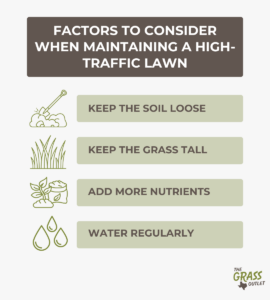
Start by maintaining the grass at the tallest height suitable for its specific variety. Longer blades provide extra cushioning, helping to reduce the impact of footsteps.
Varying your mowing patterns is also important. To keep your grass longer, avoid mowing the lawn the same path each time, as this prevents excessive wear on any single area of your lawn.
Add more nutrients and water
High-traffic lawns need extra nutrients and regular watering to stay strong and resilient. These areas are often under stress, leading to potential damage to grass blades and compacted soil. Applying fertilizer provides nutrients like nitrogen, phosphorus, and potassium, vital for robust root development, growth, and overall lawn health.
Proper watering ensures the soil remains hydrated, especially in high-traffic spots where compaction can limit moisture penetration. Well-hydrated soil helps the grass absorb nutrients more efficiently. Additionally, water is essential for photosynthesis and regrowth.
Maintenance Tips for High-Traffic Grass Varieties
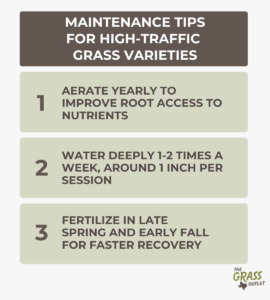
Therefore, proper lawn care is essential to prevent problems caused by soil compaction and to maintain a healthy lawn. Follow these maintenance practices to help your lawn stay resilient:
Aeration: Use a plug aerator to create small holes in the soil, allowing air, water, and nutrients to reach the roots more effectively. It’s generally recommended to aerate your lawn once a year, ideally at the start of the growing season. This process can also be done in early spring, just before planting grass plugs. After aeration, follow up with suitable fertilization or add organic materials to promote growth.
Frequent Watering: As mentioned, high-traffic areas often require more frequent watering due to soil compaction and stress. Adequate water is essential for plants to absorb the nutrients supplied by fertilizer. Without proper moisture, the fertilizer’s effectiveness in supporting healthy growth is significantly reduced.
Water your lawn deeply but less frequently to promote strong, deep root growth. Bermuda and Zoysia grasses are drought-tolerant. They typically do well with one to two weekly watering sessions during their active growing season as long as they receive around an inch of water each time.
The soil softens immediately after watering or heavy rain, making it more prone to compaction. Additionally, wet grass is easily damaged, so it’s best to schedule irrigation so the lawn is dry, mainly during periods of heavy use. Similarly, limit foot traffic after heavy rainfall until the lawn has dried and regained its firmness to prevent soil compression and damage.
Fertilization: Proper fertilization and watering supply the essential resources for rapid growth, allowing the grass to recover from damage and maintain a dense turf that can withstand future wear.
Fertilize your lawn regularly to promote healthy growth. Opt for a balanced fertilizer or one rich in nitrogen to support quicker recovery. For the best results, apply fertilizers in late spring and early fall.
Choosing the Right Grass for Your Lawn
To sum up, how do you select the best grass varieties for your area?
One of the most important factors is choosing a grass type that thrives in your local climate. When picking the best grass for Texas, it’s crucial to consider the state’s unique climate and soil conditions. Texas faces intense heat, varying rainfall patterns, and a range of soil types, making it essential to select grass varieties that are drought-resistant, resilient, and well-suited to specific regions. Typically, these are warm-season grasses.
Sunlight is another important consideration. Take note of how much sunlight your lawn receives throughout the day – whether full, partial, or minimal.
Finally, consider how you use your lawn. Fast-recovering grass varieties benefit high-traffic areas. Opting for one of the previously mentioned grasses for high-use areas will help your lawn withstand frequent foot traffic while retaining its health and visual appeal.
Homeowners in Texas can take advantage of The Grass Outlet’s diverse selection of high-traffic grass varieties, specially tailored to local conditions for optimal growth and durability.
Conclusion
The most effective way to manage heavy foot traffic on your lawn is to start with the right grass variety. Selecting suitable turf and applying proper care techniques can help maintain a lush, durable lawn that can withstand frequent use.
If you’re constantly battling unsightly brown patches despite regular maintenance, it might be time to consider a more traffic-resistant grass option. The Grass Outlet offers a wide range of high-traffic grass varieties. Feel free to contact us for sod recommendations and expert guidance in choosing the perfect grass to meet your lawn’s demands.

